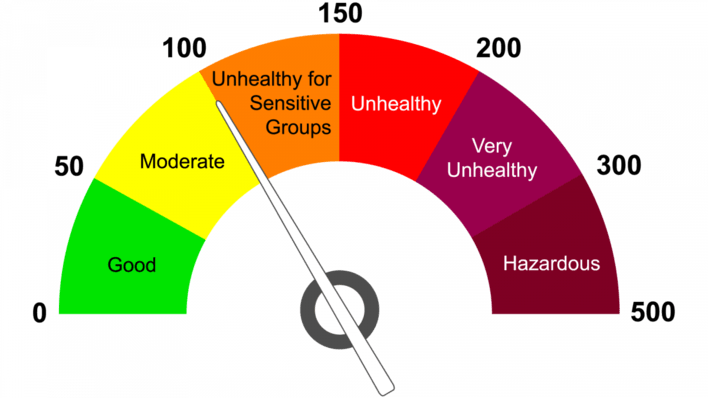The city experienced a decline in air quality on Monday, with the overall air quality index (AQI) reaching 206 (PM2.5) levels, according to data from the US Mission India’s NowCast Air Quality Index. Pollution control board standards categorize AQI values, with 0–50 considered good, 51–100 satisfactory, 101–200 moderate, 201-300 poor, 301–400 very poor, and 401–450 severe. An official from the West Bengal Pollution Control Board (WBPCB) revealed the city’s annual average PM2.5 level stands at 174.
The elevated AQI observed on Monday is attributed to wintry conditions trapping fine particulate matter, resulting in smog formation during late afternoon and early morning hours. However, the Fort William air monitoring station recorded an AQI of 186 PM2.5, and the Victoria Memorial station reported 164.
During the weekend, both stations registered AQI levels ranging from 232 to 248 PM2.5 due to smog at dawn and dusk, as reported by the WBPCB official. He expressed concern for individuals with respiratory conditions due to the current AQI level, emphasizing the need for vigilance.
Also read: Karnataka Health Department Issues Zika Virus Advisory
The WBPCB has taken preventive measures, including banning the use of chullahs (coal-driven ovens used by vendors), instructing real estate developers to cover construction sites to control dust particles, and deploying water sprayer tankers in the city.
Naba Dutta, secretary of the environmental NGO Sabuj Mancha, voiced apprehension about the upcoming Diwali and Kali Puja festivals, predicting a further decline in air quality due to firecracker usage. He cautioned about potential respiratory issues among the populace as air pollution continues to rise.
With Diwali and Kali Puja barely a week away, the air quality is likely to further worsen because of bursting of firecrackers. People are already experiencing breathing problems and there may be a rise in the number of patients with respiratory issues due to the spike in air pollution in the coming days.
Meanwhile: Delhi’s Air Quality Plunges to Alarming Depths: Residents Grapple with ‘Critical’ Pollution Crisis
In a disconcerting turn of events, Delhi woke up to a thick blanket of toxic smog enveloping the city on Monday morning, marking an unprecedented ‘critical’ categorization on the Air Quality Index (AQI) scale, as reported by the System of Air Quality and Weather Forecasting and Research (SAFAR)-India. The overall AQI for the national capital soared to a staggering 471, signifying a severe deterioration in air quality. Specific areas within the city were hit even harder, with Delhi University recording an AQI of 473, Terminal 3 airport at an alarming 559, Noida at 616, IIT Delhi at 517, and Gurugram at 516, all registering in the ‘critical’ range, according to SAFAR’s 7 a.m. data.
Furthermore, prominent locations like Pusa and Lodhi Road, which logged AQI levels of 407 and 450 respectively, fell under the ‘severe’ category, adding to the growing concerns among citizens. The situation is exacerbated by a multitude of factors, including unfavorable weather conditions, vehicular emissions, the burning of crop residues, rampant use of firecrackers, and various local sources of pollution. These elements, when combined, contribute to Delhi’s annual winter air quality crisis, creating a hazardous environment for its residents.
Notably, the hazardous air quality isn’t confined to Delhi alone; neighbouring cities such as Ghaziabad, Gurugram, Noida, Greater Noida, and Faridabad are also grappling with similarly dire conditions, highlighting the regional nature of the problem.
Also read: Study Suggests Covid-19 Pandemic May Have Exacerbated Dengue Impact in India
Particulate Matter 2.5 (PM2.5), consisting of fine particulate matter capable of infiltrating the respiratory system, far exceeded the government-mandated safe threshold of 60 micrograms per cubic meter in various locations across Delhi-NCR. Shockingly, PM2.5 levels were recorded at levels 30 to 40 times higher than the recommended limit of 15 micrograms per cubic meter set by the World Health Organization (WHO). These alarming figures underscore the imminent health risks faced by residents, especially those vulnerable, such as children and the elderly.
In response to the crisis, local authorities and the Commission for Air Quality Management (CAQM), a mandated institution focused on addressing pollution issues, have implemented stringent measures. These include a ban on construction activities related to linear public projects and the encouragement of remote work for 50% of government and private office employees. The Transport Department has also deployed multiple teams to enforce these restrictions and ensure compliance.
To safeguard the well-being of young children, the Delhi government has taken a proactive step by temporarily shutting down all primary schools for two days. This move aims to shield the younger generation from the harmful effects of pollution, given the severe health risks posed by the current air quality.
As Delhi and its neighbouring regions grapple with this perilous air quality crisis, the urgent need for sustainable solutions and collective efforts to curb pollution becomes increasingly evident. The situation calls for immediate and decisive action from authorities and citizens alike, to mitigate the adverse effects of this environmental emergency.

